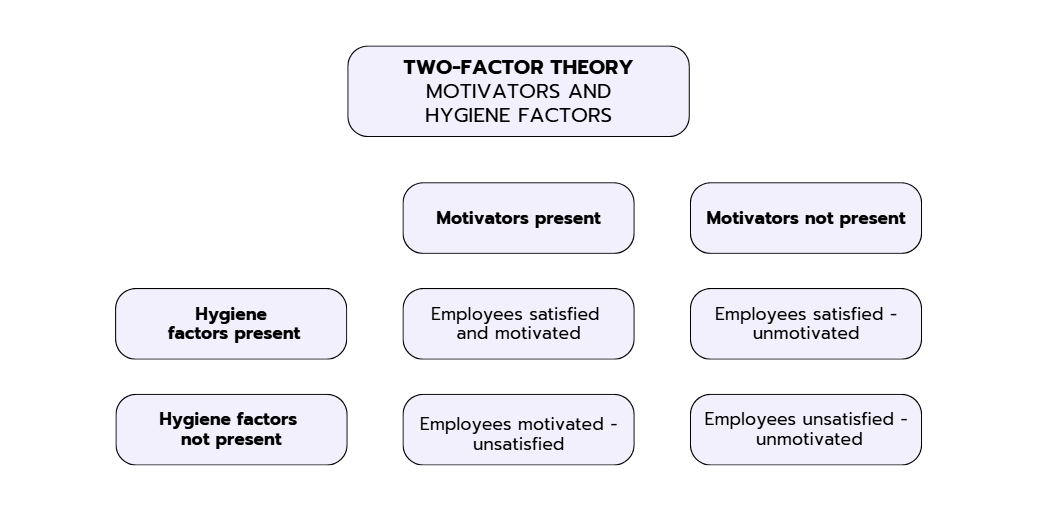The Herzberg 2-factor-theory, also known as the two-factor theory or motivation-hygiene theory, was developed in the 1950s by Frederick Herzberg. Herzberg was an American industrial scientist and psychologist who taught as a professor at various universities. His research interests focused on what makes people satisfied at work.
His theory aims at explaining and influencing motivation and satisfaction at work. It postulates that there are two distinct groups of factors that influence job satisfaction and dissatisfaction, and they have different effects on employees.
Herzberg's research findings are also more relevant than ever in today's work environment, especially in light of the shortage of skilled workers, burnout, and in the debate about a 4-day work week.
Hygiene Factors (Dissatisfaction Avoidance)
Hygiene factors are also known as "waiting room factors" because they only help to prevent dissatisfaction at work, but do not necessarily contribute to motivation. These factors are basic conditions that must be present in a company to satisfy employees and prevent dissatisfaction. They include things like adequate pay, job security, company values, support services and autonomy experiences, as well as leadership styles and relationships with supervisors and colleagues.
When these factors are lacking or inadequate, employees can become dissatisfied, but improving them doesn't necessarily lead to higher motivation.
Herzberg uses the term hygiene deliberately to make clear that poor working conditions can make people sick like a bacterium. Hygiene factors, on the other hand, can avoid this process.
Motivators (Satisfaction Promotion)
Motivators are the factors that actually motivate employees and help increase their job satisfaction. They are usually related to the work itself and personal growth opportunities. They include recognition for good performance, interesting tasks, assumption of responsibility, professional development opportunities and the chance to use personal skills and competencies. When these factors are present in the work environment, employee motivation increases, leading to higher job satisfaction and performance.
Combination of Both Factors
The graphic is intended to show which effect the combination of the two factors can have:

- Scenario 1: many hygiene factors, many motivation factors present.
The employee is motivated and satisfied. There are few complaints, few absences, and morale is high in this ideal state. - Scenario 2: many motivational factors, few hygiene factors.
In this scenario, employees are dissatisfied with external conditions but are basically motivated. For example, there are many conflicts due to an inappropriate management style of a boss, but at the same time development opportunities are given and an employee experiences appreciation from colleagues. Motivation for the work itself remains high, but loyalty to the company can suffer. - Scenario 3: few motivating factors, many hygiene factors.
Employees have few complaints, but they are not very motivated for their work because they lack the prospect of promotion, for example, or appreciation of their work. - Scenario 4: Low motivation factors, few hygiene factors.
In this scenario, general dissatisfaction prevails. In the long term, this combination leads to resignations or health-related absences and should be avoided.
Criticism
Although Herzberg's model could certainly improve working conditions in many companies, there are also points of criticism:
- Simple dichotomous classification:
One of the main criticisms of Herzberg's theory is the very simple and dichotomous classification of factors into hygiene factors (also called maintenance factors or extrinsic factors) and motivational factors (also called satisfaction factors or intrinsic factors). Herzberg suggested that hygiene factors can only prevent dissatisfaction, while motivational factors actually increase satisfaction and performance. However, this categorization ignores the fact that reality is more complex, and there is often an interaction between these factors. - Lack of empirical evidence:
Another criticism is that Herzberg's theory has not been adequately supported by extensive empirical research. Although his original studies provided some qualitative results, they were often considered methodologically questionable. The theory could not always be replicated in different organizational contexts and cultures. - One-dimensional view of motivation:
Two-factor theory tends to portray motivation as a simple either-or proposition, where people are either motivated or they are not. In reality, however, motivation is a complex phenomenon influenced by many factors, including individual needs, values, expectations, and personal goals. - Limited consideration of social aspects:
Herzberg's theory focuses mainly on individual factors and often neglects the social and interpersonal aspects of job satisfaction. Other theories such as social exchange theory and social identity theory emphasize the importance of social relationships in the workplace. - Overemphasis on intrinsic motivation:
Herzberg's theory places strong emphasis on intrinsic motivation and personal performance factors. However, it neglects the fact that extrinsic factors such as salary, working conditions, and recognition can also play an important role in employee motivation. - Lack of consideration of change and dynamics:
The two-factor theory tends to view job satisfaction as a static characteristic and does not consider the possibility that it may change over time. However, in today's fast-paced work environment, employee motivation and satisfaction are often unstable and subject to constant change.
Relevance For The Management Consulting Industry
The Herzberg 2-factor theory has considerable relevance for the management consulting industry, as it is crucial in shaping working conditions and motivating employees. In this industry, highly skilled and motivated employees are critical to solving complex problems and developing client-focused solutions. Companies in the management consulting industry must ensure that they not only meet the basic conditions (hygiene factors) to prevent dissatisfaction, but also promote the motivators to increase job satisfaction and motivation of their employees.
This means that companies in the management consulting industry need to provide challenging and interesting projects that utilize the skills and talents of their employees, provide them with recognition and development opportunities, and create a positive work environment. By taking the Herzberg 2-factor theory into account and increasing the motivation of their employees, management consulting companies can improve their performance and customer satisfaction, which ultimately leads to long-term success.

